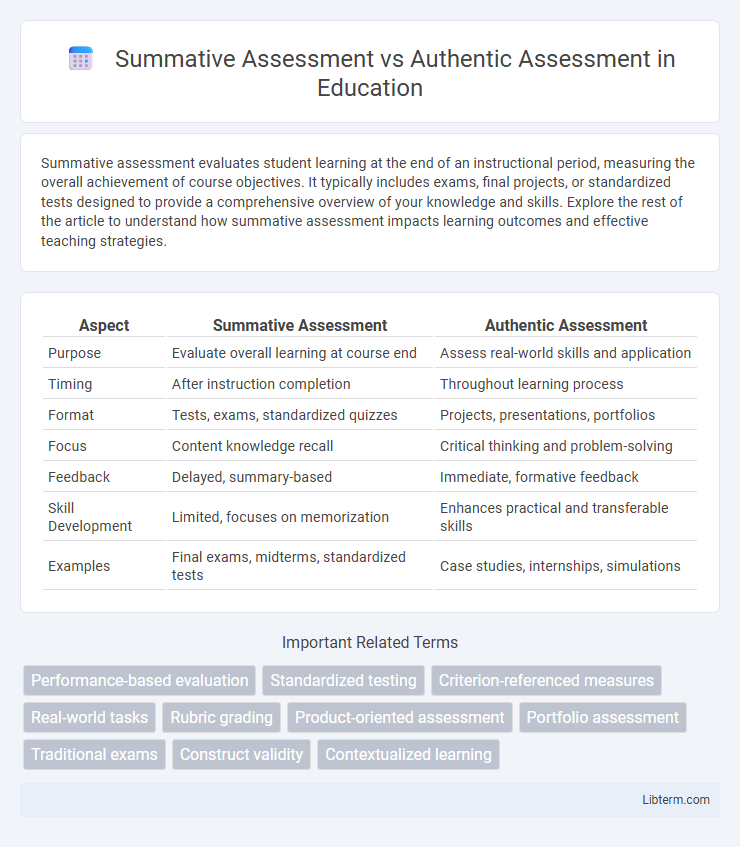Summative assessment evaluates student learning at the end of an instructional period, measuring the overall achievement of course objectives. It typically includes exams, final projects, or standardized tests designed to provide a comprehensive overview of your knowledge and skills. Explore the rest of the article to understand how summative assessment impacts learning outcomes and effective teaching strategies.
Table of Comparison
| Aspect | Summative Assessment | Authentic Assessment |
|---|---|---|
| Purpose | Evaluate overall learning at course end | Assess real-world skills and application |
| Timing | After instruction completion | Throughout learning process |
| Format | Tests, exams, standardized quizzes | Projects, presentations, portfolios |
| Focus | Content knowledge recall | Critical thinking and problem-solving |
| Feedback | Delayed, summary-based | Immediate, formative feedback |
| Skill Development | Limited, focuses on memorization | Enhances practical and transferable skills |
| Examples | Final exams, midterms, standardized tests | Case studies, internships, simulations |
Understanding Summative Assessment
Summative assessment evaluates student learning by measuring knowledge retention and skill mastery at the end of an instructional unit, typically through standardized tests, final exams, or major projects. It provides quantifiable data that educators use to assign grades and determine overall academic achievement. Unlike authentic assessment, summative assessment focuses on outcomes rather than the application of skills in real-world contexts.
Defining Authentic Assessment
Authentic assessment measures a learner's ability to apply knowledge and skills to real-world tasks, emphasizing practical relevance over theoretical understanding. Unlike summative assessment, which typically evaluates learning through standardized tests at the end of an instructional period, authentic assessment involves performance-based tasks such as projects, presentations, or portfolios that reflect everyday challenges. This approach provides a more comprehensive evaluation of student competencies, critical thinking, and problem-solving abilities in authentic contexts.
Key Differences Between Summative and Authentic Assessment
Summative assessment evaluates student learning at the end of an instructional unit by comparing it against a standard or benchmark, often through exams or standardized tests. Authentic assessment measures students' ability to apply skills and knowledge in real-world or practical contexts, such as projects, portfolios, or performances. Key differences include the timing and purpose--summative assessment is evaluative and final, while authentic assessment is formative and ongoing, emphasizing real-life application and deeper understanding.
Purpose and Goals of Each Assessment Type
Summative assessment aims to evaluate student learning by measuring mastery of content at the end of an instructional period, providing grades or scores that reflect overall achievement. Authentic assessment focuses on applying knowledge and skills in real-world contexts, emphasizing practical understanding and critical thinking to prepare learners for actual challenges. The purpose of summative assessment is to quantify learning outcomes, while authentic assessment aims to develop and demonstrate competencies through meaningful, context-based tasks.
Methods and Examples of Summative Assessment
Summative assessment methods typically include final exams, standardized tests, end-of-unit quizzes, and comprehensive projects that evaluate a student's overall learning at the conclusion of an instructional period. Examples of summative assessments are state-level assessments, final course exams, cumulative essays, and standardized achievement tests such as the SAT or ACT. These assessments aim to measure the extent of student learning by providing quantifiable data on knowledge and skills mastery.
Methods and Examples of Authentic Assessment
Authentic assessment methods emphasize real-world tasks that demonstrate practical application of knowledge, such as portfolios, performance tasks, and project-based learning, contrasting with summative assessments that typically use standardized tests or final exams to evaluate cumulative knowledge. Examples of authentic assessment include student-led presentations, scientific investigations, and collaborative group projects that assess critical thinking and problem-solving skills in context. These methods provide deeper insights into students' abilities by integrating assessment with meaningful learning activities.
Advantages of Summative Assessment
Summative assessment offers clear advantages in measuring student learning by providing standardized, objective data that can be easily quantified and compared across groups. It helps educators identify overall achievement levels and curriculum effectiveness at the end of instructional periods, supporting accountability in education systems. Summative assessments also streamline grading processes, enabling efficient reporting of student performance to stakeholders.
Benefits of Authentic Assessment
Authentic assessment benefits include measuring student skills in real-world contexts, promoting deeper understanding and critical thinking. This approach fosters student engagement by connecting tasks to practical applications, enhancing motivation and retention. It also provides educators with meaningful insights into students' abilities beyond traditional testing metrics, supporting personalized learning strategies.
Challenges and Limitations of Both Approaches
Summative assessment faces challenges such as limited insight into ongoing student learning and a focus on rote memorization rather than critical thinking. Authentic assessment struggles with scalability and subjectivity in grading, making consistent evaluation difficult across diverse learners. Both approaches may encounter limitations in addressing individual learning needs and providing timely feedback for improvement.
Choosing the Right Assessment for Learning Outcomes
Summative assessment evaluates student learning at the end of an instructional period through standardized tests, final projects, or exams, providing quantifiable data on achievement. Authentic assessment measures students' ability to apply knowledge in real-world contexts using portfolios, performances, or simulations, emphasizing practical skills and critical thinking. Choosing the right assessment depends on aligning methods with learning outcomes: summative assessments suit knowledge retention and standardized objectives, while authentic assessments excel in measuring applied skills and deeper understanding.
Summative Assessment Infographic

 libterm.com
libterm.com